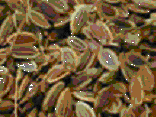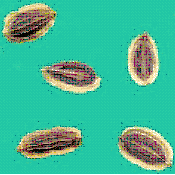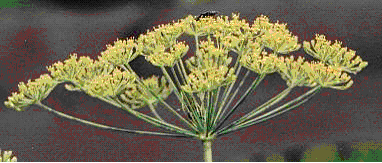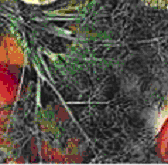Dill
| |
Egyptology Articles
Herbs and Aroma
Alternative
Medicine
Aroma Therapy
|
|
This herb is one of the most famous and popular herb in many cuisines
together with its use as a medicine especially for children.In
ancient Egypt it was also used as a main ingredient in a pain killing
mixture. It is another herb containing aromatic volatile oil .Its
common name is dill seed, dill fruit or just dill.Its name is probably
derived from
the Saxon word ‘dilla’ or ‘dillan’, the translation
being ‘to lull’. This name could refer to the properties that dill
possesses in terms of being able to pacify and calm babies with colic or
flatulence.
Dill leaves are feathery
and thread like in appearance and have yellow flowers. In terms of
taste, they are very similar to that of caraway, but have a tangy,
grassy flavour to them along with a hint of lemon, pine and fennel.
This is a delicately flavored herb with lots of culinary and
medicinal uses since ancient times.
The characteristic, sweet taste of
dill is popular all over central and eastern Europe, & western, central and
southern Asia,
Sweet and aromatic, intermediate between
anise and
caraway. The herb, especially when fresh, has a much sweeter fragrance than
dried fruits.
Dill seeds and leaves impart a wonderful aroma. This
popular herb has a faint, almost a similar scent of aniseed.
Dill
seeds make an attractive addition to soaps. They are a pale taupe color with a
brown stripe down their length.
|
 |
| |
Dill Flower |
|

|
Its main constituent is an oil
obtained from the fruit which is almost identical to oil of caraway, both
containing limonene and carvone.
The essential oils from leaves (0.35%)
and fruits (2 to 4%) differ slightly in composition: In the fruit oil, the main
components are carvone (40 to 60%) and limonene (40%). In the leaf oil, the
aroma is determined by carvone (30 to 40%), limonene (30 to 40%), phellandrene
(10 to 20%) and other monoterpenes; dill ether (a monoterpene ether) is
characteristic of dill leaf oil.
Most imported dill stems from
Egypt, other Mediterranean countries or Eastern Europe.
Uses:
The leaves and
seeds of the Dill plant are extensively used in the preparation of wide range of
meals. Dill can be grown as a
windowsill plant, or it can be grown outdoors.
Dill
seeds are used whole or ground as a condiment for flavouring meats, sauces,
stews, breads, vinegars, pastries, and vegetable. Dried and fresh leaves are
used in sauces, salads, soups, stews, and vinegars.
The
seeds are used in pickling and can also improve the taste of roasts, stews and
vegetables. Ground seeds are used as a salt substitute.
Dill
is an important flavouring agent in the pickling of cucumbers. Some dill oil is
used in cosmetics and perfumes. Dried dill foliage is commonly called dill weed.
The
taste of dill leaves resemble that of caraway, while the seeds are pungent and
aromatic. Freshly cut, chopped leaves enhance the flavour of dips, herb butter,
soups, salads, fish dishes, and salads.
The characteristically subtle flavor of Dill complements most fish dishes,
particularly Salmon. Dill is also invaluable as a flavoring for salads, potato
dishes, and sauces. Care must be taken to add Dill at the last moment in the
cooking process. The flavor of Dill vanishes if it is over cooked.
The leaves can also be added
into cottage cheese to add a something special. They can also be added to bean
soups to add to the taste and prevent flatulence.
A
very famous dish in the Arabic world is “mahashi” which is equivalent to stuffed
vegetables. All types of vegetables are used as courgettes, tomatoes eggplant,
green pepper and more. The dill leaves are the main ingredient used for stuffing
together with rice, parsley, onions and chopped tomatoes.
Dill
leaves can also be used to generate oil which is pale yellow in colour, but
darkens in time.
The
fruit of the dill leaf can generate about 3.5% oil and is a mixture of a
paraffin hydrocarbon and d-carvone with limonene. Caraway and Dill oils are
almost identical in composition other than the fact that dill oil contains less
carvone than caraway oil.
Like
the dill seeds and leaves, the oil possesses similar properties and has
considerable medicinal uses. Most common is its use in the preparation of dill
water, used for treating children suffering from flatulence and other children’s
medicines. It is also used for perfuming soap.
Japan
and India also export dill oil. However, it is different from the European dill
oil as it contains less carvone. Strangely enough, African dill oil is produced
from plants grown from seeds imported from England. They tend to produce more
oil than the European counterparts.
Medicinal uses
It is Stimulant, aromatic, carminative and stomachic. It is usually given as
dillwater which is very good for children’s flatulence or disordered digestion.
Amongst its other
properties, Dill is known for acting as an antibacterial and antispasmodic agent
and as a diuretic. However, its main purpose is for calming the digestive
system. The essential oil found in Dill assists in relieving intestinal spasms
and griping so it can be found in many gripe water mixtures and for those
suffering from colds and other such related ailments, dill is often added to
cold and flu remedies.
Oil of dill is used in medicine in largely the same way, but is also used in
perfuming soaps.
It also stimulates lactation.
It is administered as distilled water, essential oil.
Its Botanical
name is fructus anethi or more precisely
Dill seed being
(Anethum graveolens)
Its Arabic name is Shabath, Shibitt or
Shabat.
Ancient Romans believed dill had fortifying qualities. Gladiators were given food
covered with dill, to give them strength. It is one of the earliest
medicinal herbs known in Europe, widely regarded as one of the best stomachics
for young children.
The parts used are the dried ripe fruit.
Of dill, both the dried fruits
(misnamed “dill seeds”) and the fresh or dried arial parts (“dill weed”) are
used. Fresh dill herb is much more aromatic than the dried one.
Dill grows in
the Mediterranean region and Southern Russia. It can also be found growing wild
amongst the corn in Spain and Portugal and around the coast of Italy, and rarely
grows in parts of Northern Europe.
|
You may freely reprint this article
or place it on your website by
adding this statement: Courtesy of www.kingtutshop.com
|




